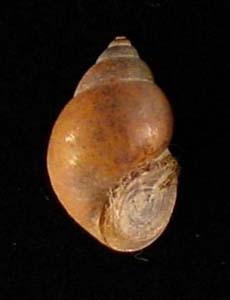Faucet Snail

Species at a Glance
The faucet snail (Bithynia tentaculata) is a small freshwater snail that grazes and filters algae from lakes. It is native to Europe and was most likely introduced to the Great Lakes through contaminated solid ballast of large timber transport ships, or from vegetation used in packing crates. The faucet snail competes with native snails for food and habitat, serves as an intermediate host of parasites that are a threat to waterfowl, and clogs municipal water supplies and intakes.
Identification
The shell of the faucet snail is usually 12–15 mm (0.4 – 0.6 inches), pale brown in color, oval in shape, and has 4-5 coils (whorls). The opening of the shell is located on the right-hand side when the shell is pointed up. A trapdoor-like opening called an operculum covers the opening (aperture) and has concentric rings that resemble a bullseye. The faucet snail has long, pointed tentacles and a simple foot with lobe acting as a channel for water.
Similar Species
The faucet snail can be confused with the New Zealand mudsnail (Potamopyrgus antipodarum), young Mystery Snails, and some other small native snail species. It is often difficult to identify conclusively. New Zealand mudsnails differ from faucet snails in that they have 5-8 whorls that come to a point at the top, are longer and narrower than the faucet snail, and some have a keel in the middle of each whorl.
Habitat
Commonly found in freshwater ponds, shallow lakes, and canals, the faucet snail attaches to objects in the water. In fall and winter months it is usually found on rocks and bottom substrates but moves to aquatic plants in warmer months. Due to its ability to filter feed, the faucet snail population can survive in water bodies that are disturbed and high in nutrients.
Spread
The faucet snail was most likely introduced to the Great Lakes basin by hitchhiking in packaging material, through solid ballast in timber ships, or by deliberate release. Having the ability to attach to boats, trailers, docks, and other equipment, the faucet snail can be spread through the transportation of water-related equipment. It also has the ability close its operculum and survive out of water for several days.
Distribution
Native to Europe, the faucet snail was first introduced to the United States at the Great Lakes in the 1870s. Populations outside of the Great Lakes are likely the result of the species spreading from the Great Lakes rather than separate introductions. In Pennsylvania, the faucet snail can be found in a few north eastern and north central counties.
Environmental Impacts
The faucet snail outcompetes native snail species for food and habitat and acts as a vector for passing three types of trematode parasites, which can be fatal to waterbirds that eat this snail. It also impacts municipal water supplies by clogging water intake pipes and other submerged equipment.
References:
Kipp, R.M., A.J. Benson, J. Larson, and A. Fusaro, 2021, Bithynia tentaculata (Linnaeus, 1758): U.S. Geological Survey, Nonindigenous Aquatic Species Database, Gainesville, FL,
Mud Bithynia — Bithynia tentaculata. Montana Field Guide. Montana Natural Heritage Program.
Simithsonian Environmental Research Center, 2021, Bithynia tentaculate – Mollusks-Gastropods.
Department of Natural Resources, 2021, Faucet Snail (Bithynia tentaculata),
U.S. Fish and Wildlife Service, 2015, Faucet Snail (Bithynia tentaculata), Ecological Risk Screening Summary.
University of Wisconsin Sea Grant, Faucet Snail.



